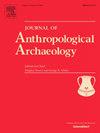From space to Place: The making of temples
IF 2.2
1区 社会学
Q1 ANTHROPOLOGY
引用次数: 0
Abstract
This paper investigates temple-building traditions using concepts of space and place, exploring various perspectives of temple placemaking in archaeological, textual and ethnographic data. The study first looks at temple-building practices in Mesopotamia and South Asia, before exploring the nature of temple-building traditions in the 2nd and 1st millennium BCE southern Levant. From Mesopotamia, a unique temple foundation ritual from the 1st millennium BCE is analyzed in order to provide one perspective on how a space is turned into sacred place. The study then focuses on the role that sacred models (mandalas) play in building and conceptualizing temples in South Asian traditions, as well as how ritual dances generate demarcated ritual places. Using and applying various ideas encountered in the first two case studies, the article then investigates the Bronze and Iron Age archaeological data of the Levant for traces of sacred placemaking. Amongst the various observations on how Levantine temples were conceptualized as places, the study identifies a fundamental distinction between institutionalized and non-institutionalized temple-building traditions.
从空间到地点:寺庙的建造
本文利用空间和地点的概念研究寺庙建造传统,从考古、文本和人种学数据中探索寺庙地点建造的各种视角。研究首先考察了美索不达米亚和南亚的建庙习俗,然后探讨了公元前 2 世纪和公元前 1 世纪南黎凡特地区建庙传统的性质。研究分析了美索不达米亚公元前一千年独特的神庙奠基仪式,以便从一个角度探讨如何将空间变为圣地。随后,研究重点关注了神圣模型(曼陀罗)在南亚传统寺庙的建造和概念化过程中发挥的作用,以及仪式舞蹈如何产生划定的仪式场所。文章利用并应用了前两个案例研究中的各种观点,然后调查了黎凡特青铜时代和铁器时代的考古数据,以寻找圣地建造的痕迹。在对如何将黎凡特神庙概念化为场所的各种观察中,该研究确定了制度化和非制度化神庙建造传统之间的根本区别。
本文章由计算机程序翻译,如有差异,请以英文原文为准。
求助全文
约1分钟内获得全文
求助全文
来源期刊

Journal of Anthropological Archaeology
Multiple-
CiteScore
4.00
自引率
11.10%
发文量
64
期刊介绍:
An innovative, international publication, the Journal of Anthropological Archaeology is devoted to the development of theory and, in a broad sense, methodology for the systematic and rigorous understanding of the organization, operation, and evolution of human societies. The discipline served by the journal is characterized by its goals and approach, not by geographical or temporal bounds. The data utilized or treated range from the earliest archaeological evidence for the emergence of human culture to historically documented societies and the contemporary observations of the ethnographer, ethnoarchaeologist, sociologist, or geographer. These subjects appear in the journal as examples of cultural organization, operation, and evolution, not as specific historical phenomena.
 求助内容:
求助内容: 应助结果提醒方式:
应助结果提醒方式:


